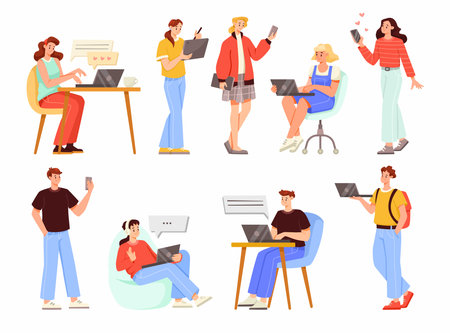Introduction to Mobility and Workplace Wellness
For office workers across the UK, daily movement is increasingly recognised as essential for maintaining both health and productivity. With many professionals spending upwards of seven hours each day seated at their desks, sedentary routines have become the norm, often leading to a host of musculoskeletal problems, decreased energy levels, and even long-term health conditions such as obesity and cardiovascular disease. In fact, recent data from Public Health England highlights that physical inactivity is now one of the leading risk factors for poor health in the workplace. Moreover, research shows that incorporating regular mobility exercises into your daily schedule can significantly boost concentration, reduce stress, and improve overall wellbeing. Understanding the importance of movement isnt just about preventing aches and pains—its about creating a culture of wellness that supports sustainable work performance for office workers throughout the UK.
Understanding Sedentary Risks in UK Office Culture
Modern office culture across the UK is increasingly characterised by prolonged periods of sitting and low physical activity. According to recent data from the British Heart Foundation, the average UK office worker spends around 9 hours a day seated at their desk. This sedentary lifestyle is further exacerbated by common commuting patterns—many workers travel by car or public transport, adding extra hours of inactivity.
UK-Specific Working Habits and Inactivity
Remote and hybrid working arrangements have become more prevalent post-pandemic, but this has not necessarily improved mobility among office staff. A 2023 survey by Public Health England found that only 34% of adults in full-time employment achieve the NHS-recommended 150 minutes of moderate-intensity activity per week. The table below outlines typical daily routines and associated sedentary periods:
| Activity | Average Time Spent (Hours) |
|---|---|
| Desk Work | 7.5 |
| Commuting | 1.0 |
| Meetings/Calls | 1.5 |
| Total Sedentary Time | 10.0 |
Musculoskeletal Health Implications
This level of inactivity has measurable effects on musculoskeletal health. NHS reports show that back pain, neck stiffness, and repetitive strain injuries are now leading causes of sick leave among UK office workers. Furthermore, workplace wellbeing surveys indicate that employees experiencing poor mobility are twice as likely to report low mood and reduced productivity.
The Case for Daily Mobility Exercises
The growing prevalence of sedentary risks highlights the urgent need for practical interventions, such as daily mobility exercises tailored for office environments. Implementing simple movement routines can help mitigate these risks, improve posture, and enhance overall wellbeing for workers throughout the UK.

3. Selecting Effective Daily Mobility Exercises
When curating a set of mobility exercises tailored for office workers across the UK, it is essential to focus on practicality, time-efficiency, and evidence-based outcomes. The typical UK office environment presents unique challenges: prolonged sitting, limited space, and often a fast-paced work culture. Therefore, choosing the right exercises requires careful consideration of several criteria to ensure they are both accessible and beneficial for employees.
Practicality in the Modern UK Workplace
Mobility routines must seamlessly integrate into the average workday without causing major disruptions. Exercises that require minimal equipment—such as chair stretches or standing movements—are preferable. Additionally, it is important to select movements that can be performed in standard office attire and within confined spaces, such as next to a desk or in a communal break area.
Time-Efficiency: Maximising Benefits in Minutes
The majority of UK office workers have limited time for wellness activities during working hours. Evidence suggests that even brief movement breaks can enhance circulation and reduce musculoskeletal discomfort. Therefore, each recommended exercise should take no more than two minutes to complete, allowing employees to perform several throughout the day without impacting productivity.
Evidence-Based Health Benefits
To ensure the selected mobility routines are genuinely effective, it is crucial to prioritise exercises supported by clinical research. Movements that have been shown to improve posture, decrease lower back pain, and reduce the risk of repetitive strain injuries are particularly valuable. This data-driven approach ensures that every routine included offers measurable benefits aligned with occupational health guidelines commonly referenced within the UK.
By applying these criteria—practicality, time-efficiency, and evidence-based selection—office workers across the UK can confidently adopt daily mobility exercises that support their long-term wellbeing while fitting effortlessly into their everyday routine.
4. 10 Essential Mobility Exercises for the Office
Maintaining mobility while working at a desk is crucial for office workers across the UK. Below is a comprehensive breakdown of ten essential daily exercises, each adapted to suit British workspaces and terminology. These movements can be performed at your desk or in a small office area, making them accessible even during a busy day.
| Exercise | How To Do It | Key Tips for Safety |
|---|---|---|
| Neck Rolls | Sit upright, gently roll your head clockwise and then anti-clockwise. Repeat 5 times each direction. | Keep shoulders relaxed; avoid forcing the range of motion. |
| Shoulder Shrugs | Lift both shoulders towards your ears, hold for 2 seconds, then release. Repeat 10 times. | Breathe normally; do not tense your neck. |
| Seated Spinal Twist | Sit tall, place right hand on left knee, gently twist torso to the left. Hold for 10 seconds, switch sides. | Keep hips facing forward; twist only as far as comfortable. |
| Wrist Flexor Stretch | Extend one arm, palm up. Gently pull fingers back with opposite hand. Hold 15 seconds per side. | Avoid overstretching; stop if you feel pain. |
| Desk Chest Opener | Sit or stand, interlace fingers behind back, straighten arms and lift slightly to open chest. Hold 15 seconds. | Do not arch lower back; keep core engaged. |
| Ankle Circles | Sit with feet off floor, rotate ankles clockwise then anti-clockwise, 10 times each direction per ankle. | Support yourself by holding chair if needed. |
| Knee Extensions | Sit tall, extend one leg until straight, hold 3 seconds, lower slowly. Repeat 8-10 reps per leg. | Avoid locking the knee at full extension. |
| Seated Marches | Sit upright and alternately lift knees towards chest in a marching motion for 30 seconds. | Engage core muscles; move at a steady pace. |
| Standing Calf Raises | Stand behind your chair for support, rise onto tiptoes, hold briefly, lower down. Repeat 12-15 times. | Maintain balance using the chair back as needed. |
| Hip Flexor Stretch (Desk Version) | Stand beside desk, step one foot back into a gentle lunge, keeping upper body upright. Hold 20 seconds per side. | Knees should align over ankles; don’t let front knee go past toes. |
Incorporate these mobility exercises throughout your workday to reduce stiffness and support long-term musculoskeletal health in line with NHS guidelines. For best results, set reminders to move every hour and listen to your body’s limits while performing these routines. Consistency is key—making these practices part of your daily routine can help counteract the sedentary nature of modern office life across the UK.
5. Building Movement into the British Workday
For office workers across the UK, integrating mobility exercises into a typical workday can seem challenging, especially with the prevalence of desk-based roles and traditional working hours. However, practical strategies can make these movements part of your routine without disrupting productivity or drawing unwanted attention. Here are some tailored tips to help you weave these essential exercises into your daily schedule, while staying true to local work customs.
Embrace the Tea Break Tradition
The classic British tea break is more than just an opportunity for a cuppa; it’s a perfect window for quick mobility exercises. Use this time to stand up, stretch your arms overhead, perform gentle neck rolls, or even do some ankle circles while waiting for the kettle to boil. Incorporating movement during these short breaks not only boosts circulation but also aligns with accepted office culture.
Schedule Micro-Mobility Sessions
Take advantage of natural pauses in your workday—such as after completing a task or before meetings—to perform 1-2 minute mobility routines. Set reminders on your phone or computer to prompt you every hour. Common exercises like seated spinal twists or standing hip circles require minimal space and can be done discreetly at your workstation.
Make Meetings More Active
If appropriate in your workplace, suggest walking meetings for informal catch-ups or brainstorming sessions. Walking around the office or even stepping outside for a stroll not only promotes physical health but can foster creativity and collaborative thinking—a value increasingly recognised in modern UK workplaces.
Utilise Your Commute
For those commuting by train or bus, use waiting times or less crowded moments to practice simple stretches like shoulder shrugs or wrist rotations. If you cycle or walk to work, incorporate dynamic warm-ups before setting off and gentle cool-down stretches upon arrival.
Create a Culture of Wellbeing
Lead by example and encourage colleagues to join you in brief mobility breaks. Many UK offices now have wellbeing initiatives; propose including daily group stretching sessions or lunchtime movement clubs. By normalising these habits within your team, you contribute to a healthier and more energetic work environment that aligns with both productivity goals and British values of camaraderie and support.
By thoughtfully embedding mobility exercises into everyday moments—without disrupting workflow or social norms—UK office workers can significantly enhance their comfort, posture, and overall health throughout the working week.
6. Tracking Progress and Maintaining Motivation
To fully benefit from daily mobility exercises, it’s essential to track your progress and keep motivation high. Monitoring your improvements not only provides a sense of achievement but also helps you stay accountable and committed to your routine. Many UK office workers find success by using popular wellness initiatives and digital tools designed for workplace wellbeing.
Monitoring Your Improvements
Start by setting realistic goals based on your current mobility levels. You might measure flexibility through simple self-assessments or note how often you complete the recommended exercises each week. Utilising apps like NHS Couch to 5K or FitOn can make tracking easier, as they provide structured plans and visual progress charts. Additionally, the Active 10 app, promoted by Public Health England, encourages office workers to fit in brisk walking bouts throughout their day, which complements mobility work.
Leveraging UK Wellness Initiatives
Many workplaces across the UK participate in schemes such as Cycle to Work, Step Count Challenges, or Wellbeing Wednesdays. These initiatives foster a culture of movement and camaraderie. Joining such programmes can keep you motivated through social support and friendly competition. Sharing your progress with colleagues or joining an office wellness group—either in-person or via platforms like Slack or Microsoft Teams—can further boost accountability.
Sustaining Motivation with Digital Tools
Wearable devices like Fitbit or Apple Watch are popular among UK professionals for tracking daily activity, reminders to move, and even guided stretching sessions. For those who prefer a community aspect, apps like Strava or MoveGB connect users with local activity groups and challenges, making movement more engaging and less solitary. Regularly reviewing your achievements—whether it’s increased flexibility, reduced stiffness, or simply ticking off all ten exercises each day—helps maintain enthusiasm over the long term.
Ultimately, combining personal goal-setting with available digital resources and local wellness initiatives creates an environment where maintaining daily mobility becomes both achievable and enjoyable for office workers across the UK.
7. Conclusion and Further Resources
In summary, incorporating daily mobility exercises into your routine can significantly reduce the risk of musculoskeletal discomfort and boost overall well-being for office workers across the UK. The ten exercises highlighted in this guide are simple, effective, and require minimal equipment, making them accessible to everyone regardless of their workspace setup. By dedicating just a few minutes each day, you can improve flexibility, reduce stiffness, and support long-term health.
Key Takeaways
- Consistent mobility routines help counteract the negative effects of prolonged sitting.
- Small, regular movement breaks throughout the workday are more beneficial than sporadic intensive sessions.
- Adapt exercises to suit your specific needs and workspace limitations.
- Prioritise proper technique to maximise benefits and minimise injury risks.
Reliable Resources for UK Readers
If you wish to learn more or need professional guidance, consider these trusted UK-based resources:
- NHS Live Well: Exercise – Official advice on staying active at work and home.
- Chartered Society of Physiotherapy – Evidence-based workplace exercise recommendations.
- Mind UK – Information on the mental health benefits of physical activity.
Take Action Today
Building healthier habits starts with small steps. Try integrating these ten mobility exercises into your daily schedule and encourage colleagues to join in. Over time, you’ll notice improved comfort, concentration, and productivity—making your office environment healthier for everyone involved.


